Refine search
No keyword found to refine search
keywords EN
Places
Names
188 documents found
| 1 | 4 |
Documents per page :

Demonstration in Brussels in support of the women's struggle in Iran
Nicolas Landemard / Le Pictorium
LePictorium_0267640.jpg
After the death of Mahsa Amini in Iran, many protest demonstrations took place around the world. In the Belgian capital, about 1,000 people, mostly from the Iranian community in Belgium, marched in the streets in support of the Iranian women's struggles but also against the mullahs' regime.
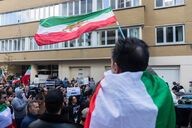
Demonstration in Brussels in support of the women's struggle in Iran
Nicolas Landemard / Le Pictorium
LePictorium_0267641.jpg
After the death of Mahsa Amini in Iran, many protest demonstrations took place around the world. In the Belgian capital, about 1,000 people, mostly from the Iranian community in Belgium, marched in the streets in support of the Iranian women's struggles but also against the mullahs' regime.

Demonstration in Brussels in support of the women's struggle in Iran
Nicolas Landemard / Le Pictorium
LePictorium_0267642.jpg
After the death of Mahsa Amini in Iran, many protest demonstrations took place around the world. In the Belgian capital, about 1,000 people, mostly from the Iranian community in Belgium, marched in the streets in support of the Iranian women's struggles but also against the mullahs' regime.
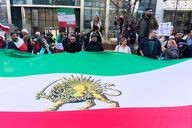
Demonstration in Brussels in support of the women's struggle in Iran
Nicolas Landemard / Le Pictorium
LePictorium_0267643.jpg
After the death of Mahsa Amini in Iran, many protest demonstrations took place around the world. In the Belgian capital, about 1,000 people, mostly from the Iranian community in Belgium, marched in the streets in support of the Iranian women's struggles but also against the mullahs' regime.

Demonstration in Brussels in support of the women's struggle in Iran
Nicolas Landemard / Le Pictorium
LePictorium_0267644.jpg
After the death of Mahsa Amini in Iran, many protest demonstrations took place around the world. In the Belgian capital, about 1,000 people, mostly from the Iranian community in Belgium, marched in the streets in support of the Iranian women's struggles but also against the mullahs' regime.

Demonstration in Brussels in support of the women's struggle in Iran
Nicolas Landemard / Le Pictorium
LePictorium_0267645.jpg
After the death of Mahsa Amini in Iran, many protest demonstrations took place around the world. In the Belgian capital, about 1,000 people, mostly from the Iranian community in Belgium, marched in the streets in support of the Iranian women's struggles but also against the mullahs' regime.

Demonstration in Brussels in support of the women's struggle in Iran
Nicolas Landemard / Le Pictorium
LePictorium_0267646.jpg
After the death of Mahsa Amini in Iran, many protest demonstrations took place around the world. In the Belgian capital, about 1,000 people, mostly from the Iranian community in Belgium, marched in the streets in support of the Iranian women's struggles but also against the mullahs' regime.
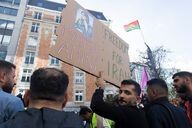
Demonstration in Brussels in support of the women's struggle in Iran
Nicolas Landemard / Le Pictorium
LePictorium_0267647.jpg
After the death of Mahsa Amini in Iran, many protest demonstrations took place around the world. In the Belgian capital, about 1,000 people, mostly from the Iranian community in Belgium, marched in the streets in support of the Iranian women's struggles but also against the mullahs' regime.

Demonstration in Brussels in support of the women's struggle in Iran
Nicolas Landemard / Le Pictorium
LePictorium_0267648.jpg
After the death of Mahsa Amini in Iran, many protest demonstrations took place around the world. In the Belgian capital, about 1,000 people, mostly from the Iranian community in Belgium, marched in the streets in support of the Iranian women's struggles but also against the mullahs' regime.

Demonstration in Brussels in support of the women's struggle in Iran
Nicolas Landemard / Le Pictorium
LePictorium_0267649.jpg
After the death of Mahsa Amini in Iran, many protest demonstrations took place around the world. In the Belgian capital, about 1,000 people, mostly from the Iranian community in Belgium, marched in the streets in support of the Iranian women's struggles but also against the mullahs' regime.

Demonstration in Brussels in support of the women's struggle in Iran
Nicolas Landemard / Le Pictorium
LePictorium_0267650.jpg
After the death of Mahsa Amini in Iran, many protest demonstrations took place around the world. In the Belgian capital, about 1,000 people, mostly from the Iranian community in Belgium, marched in the streets in support of the Iranian women's struggles but also against the mullahs' regime.

Demonstration in Brussels in support of the women's struggle in Iran
Nicolas Landemard / Le Pictorium
LePictorium_0267651.jpg
After the death of Mahsa Amini in Iran, many protest demonstrations took place around the world. In the Belgian capital, about 1,000 people, mostly from the Iranian community in Belgium, marched in the streets in support of the Iranian women's struggles but also against the mullahs' regime.
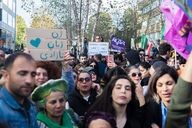
Demonstration in Brussels in support of the women's struggle in Iran
Nicolas Landemard / Le Pictorium
LePictorium_0267652.jpg
After the death of Mahsa Amini in Iran, many protest demonstrations took place around the world. In the Belgian capital, about 1,000 people, mostly from the Iranian community in Belgium, marched in the streets in support of the Iranian women's struggles but also against the mullahs' regime.
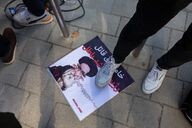
Demonstration in Brussels in support of the women's struggle in Iran
Nicolas Landemard / Le Pictorium
LePictorium_0267653.jpg
After the death of Mahsa Amini in Iran, many protest demonstrations took place around the world. In the Belgian capital, about 1,000 people, mostly from the Iranian community in Belgium, marched in the streets in support of the Iranian women's struggles but also against the mullahs' regime.

Demonstration in Brussels in support of the women's struggle in Iran
Nicolas Landemard / Le Pictorium
LePictorium_0267654.jpg
After the death of Mahsa Amini in Iran, many protest demonstrations took place around the world. In the Belgian capital, about 1,000 people, mostly from the Iranian community in Belgium, marched in the streets in support of the Iranian women's struggles but also against the mullahs' regime.

Demonstration in Brussels in support of the women's struggle in Iran
Nicolas Landemard / Le Pictorium
LePictorium_0267655.jpg
After the death of Mahsa Amini in Iran, many protest demonstrations took place around the world. In the Belgian capital, about 1,000 people, mostly from the Iranian community in Belgium, marched in the streets in support of the Iranian women's struggles but also against the mullahs' regime.
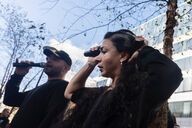
Demonstration in Brussels in support of the women's struggle in Iran
Nicolas Landemard / Le Pictorium
LePictorium_0267656.jpg
After the death of Mahsa Amini in Iran, many protest demonstrations took place around the world. In the Belgian capital, about 1,000 people, mostly from the Iranian community in Belgium, marched in the streets in support of the Iranian women's struggles but also against the mullahs' regime.

Demonstration in Brussels in support of the women's struggle in Iran
Nicolas Landemard / Le Pictorium
LePictorium_0267657.jpg
After the death of Mahsa Amini in Iran, many protest demonstrations took place around the world. In the Belgian capital, about 1,000 people, mostly from the Iranian community in Belgium, marched in the streets in support of the Iranian women's struggles but also against the mullahs' regime.
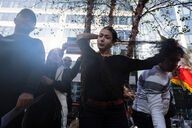
Demonstration in Brussels in support of the women's struggle in Iran
Nicolas Landemard / Le Pictorium
LePictorium_0267658.jpg
After the death of Mahsa Amini in Iran, many protest demonstrations took place around the world. In the Belgian capital, about 1,000 people, mostly from the Iranian community in Belgium, marched in the streets in support of the Iranian women's struggles but also against the mullahs' regime.
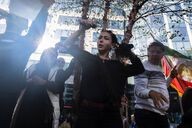
Demonstration in Brussels in support of the women's struggle in Iran
Nicolas Landemard / Le Pictorium
LePictorium_0267659.jpg
After the death of Mahsa Amini in Iran, many protest demonstrations took place around the world. In the Belgian capital, about 1,000 people, mostly from the Iranian community in Belgium, marched in the streets in support of the Iranian women's struggles but also against the mullahs' regime.
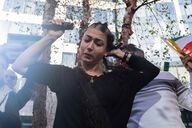
Demonstration in Brussels in support of the women's struggle in Iran
Nicolas Landemard / Le Pictorium
LePictorium_0267660.jpg
After the death of Mahsa Amini in Iran, many protest demonstrations took place around the world. In the Belgian capital, about 1,000 people, mostly from the Iranian community in Belgium, marched in the streets in support of the Iranian women's struggles but also against the mullahs' regime.
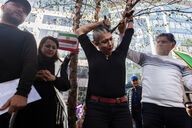
Demonstration in Brussels in support of the women's struggle in Iran
Nicolas Landemard / Le Pictorium
LePictorium_0267661.jpg
After the death of Mahsa Amini in Iran, many protest demonstrations took place around the world. In the Belgian capital, about 1,000 people, mostly from the Iranian community in Belgium, marched in the streets in support of the Iranian women's struggles but also against the mullahs' regime.
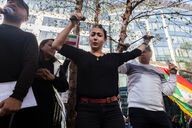
Demonstration in Brussels in support of the women's struggle in Iran
Nicolas Landemard / Le Pictorium
LePictorium_0267662.jpg
After the death of Mahsa Amini in Iran, many protest demonstrations took place around the world. In the Belgian capital, about 1,000 people, mostly from the Iranian community in Belgium, marched in the streets in support of the Iranian women's struggles but also against the mullahs' regime.
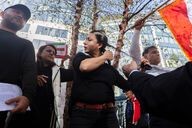
Demonstration in Brussels in support of the women's struggle in Iran
Nicolas Landemard / Le Pictorium
LePictorium_0267663.jpg
After the death of Mahsa Amini in Iran, many protest demonstrations took place around the world. In the Belgian capital, about 1,000 people, mostly from the Iranian community in Belgium, marched in the streets in support of the Iranian women's struggles but also against the mullahs' regime.

Demonstration in Brussels in support of the women's struggle in Iran
Nicolas Landemard / Le Pictorium
LePictorium_0267664.jpg
After the death of Mahsa Amini in Iran, many protest demonstrations took place around the world. In the Belgian capital, about 1,000 people, mostly from the Iranian community in Belgium, marched in the streets in support of the Iranian women's struggles but also against the mullahs' regime.

Demonstration in Brussels in support of the women's struggle in Iran
Nicolas Landemard / Le Pictorium
LePictorium_0267665.jpg
After the death of Mahsa Amini in Iran, many protest demonstrations took place around the world. In the Belgian capital, about 1,000 people, mostly from the Iranian community in Belgium, marched in the streets in support of the Iranian women's struggles but also against the mullahs' regime.
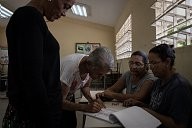
Venezuela - Maracaibo's disaster
Chris Huby / Le Pictorium
LePictorium_0186447.jpg
Venezuela - Maracaibo - Chavan district, in full election.

Trip to China.
Jean-Paul Lozouet / Le Pictorium
LePictorium_0179944.jpg
Emeishan, Sichuan, China, two Buddhist nuns walking in the rain.
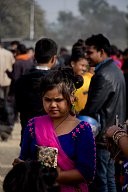
2018, Jan 15 - Maghi festival. New Year of Nepal in Tundikhel through the day. The festival had started from Kathmandu Durbar Square.
Noémie Repetto / Le Pictorium
LePictorium_0173471.jpg
Maghe Sankranti is the first day of the month of Magh of Bikram Sambat. Magh is the tenth month of the year.
Sankranti is the Sanskrit word in Eastern Astrology which refers to the transmigration of the Sun from one Rashi (sign of the zodiac) to another. In very simple, the word sankranti is the first day of the Nepali calendar. Then obviously, there are 12 sankrantis in a year. Makar Sankranti is the transition of the Sun from Dhanu rashi (Sagittarius) to Makara rashi (Capricorn).
In Hindu Astrology the sun position during the year is divided into 12 rashis (zodiac signs). It is however, very difficult to reconcile among Bikram Sambat months, Zodiac months and lunar calendar's months. While the traditional Calendar is based on lunar positions, Sankranti is a solar event. So dates of all Hindu festivals keep changing as per the Gregorian calendar and so do the Makar Sankranti too.
Makar Sankranti is the festival of the Sun God. The Sun God is the symbol of power, divinity and wisdom. The Sun God is worshiped in this festival.
Maghe Sankranti is also called Maghi. Maghi is for the New year of Tharu Community of Nepal.
Sankranti is the Sanskrit word in Eastern Astrology which refers to the transmigration of the Sun from one Rashi (sign of the zodiac) to another. In very simple, the word sankranti is the first day of the Nepali calendar. Then obviously, there are 12 sankrantis in a year. Makar Sankranti is the transition of the Sun from Dhanu rashi (Sagittarius) to Makara rashi (Capricorn).
In Hindu Astrology the sun position during the year is divided into 12 rashis (zodiac signs). It is however, very difficult to reconcile among Bikram Sambat months, Zodiac months and lunar calendar's months. While the traditional Calendar is based on lunar positions, Sankranti is a solar event. So dates of all Hindu festivals keep changing as per the Gregorian calendar and so do the Makar Sankranti too.
Makar Sankranti is the festival of the Sun God. The Sun God is the symbol of power, divinity and wisdom. The Sun God is worshiped in this festival.
Maghe Sankranti is also called Maghi. Maghi is for the New year of Tharu Community of Nepal.
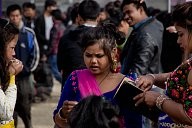
2018, Jan 15 - Maghi festival. New Year of Nepal in Tundikhel through the day. The festival had started from Kathmandu Durbar Square.
Noémie Repetto / Le Pictorium
LePictorium_0173472.jpg
Maghe Sankranti is the first day of the month of Magh of Bikram Sambat. Magh is the tenth month of the year.
Sankranti is the Sanskrit word in Eastern Astrology which refers to the transmigration of the Sun from one Rashi (sign of the zodiac) to another. In very simple, the word sankranti is the first day of the Nepali calendar. Then obviously, there are 12 sankrantis in a year. Makar Sankranti is the transition of the Sun from Dhanu rashi (Sagittarius) to Makara rashi (Capricorn).
In Hindu Astrology the sun position during the year is divided into 12 rashis (zodiac signs). It is however, very difficult to reconcile among Bikram Sambat months, Zodiac months and lunar calendar's months. While the traditional Calendar is based on lunar positions, Sankranti is a solar event. So dates of all Hindu festivals keep changing as per the Gregorian calendar and so do the Makar Sankranti too.
Makar Sankranti is the festival of the Sun God. The Sun God is the symbol of power, divinity and wisdom. The Sun God is worshiped in this festival.
Maghe Sankranti is also called Maghi. Maghi is for the New year of Tharu Community of Nepal.
Sankranti is the Sanskrit word in Eastern Astrology which refers to the transmigration of the Sun from one Rashi (sign of the zodiac) to another. In very simple, the word sankranti is the first day of the Nepali calendar. Then obviously, there are 12 sankrantis in a year. Makar Sankranti is the transition of the Sun from Dhanu rashi (Sagittarius) to Makara rashi (Capricorn).
In Hindu Astrology the sun position during the year is divided into 12 rashis (zodiac signs). It is however, very difficult to reconcile among Bikram Sambat months, Zodiac months and lunar calendar's months. While the traditional Calendar is based on lunar positions, Sankranti is a solar event. So dates of all Hindu festivals keep changing as per the Gregorian calendar and so do the Makar Sankranti too.
Makar Sankranti is the festival of the Sun God. The Sun God is the symbol of power, divinity and wisdom. The Sun God is worshiped in this festival.
Maghe Sankranti is also called Maghi. Maghi is for the New year of Tharu Community of Nepal.
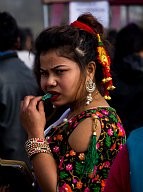
2018, Jan 15 - Maghi festival. New Year of Nepal in Tundikhel through the day. The festival had started from Kathmandu Durbar Square.
Noémie Repetto / Le Pictorium
LePictorium_0173473.jpg
Maghe Sankranti is the first day of the month of Magh of Bikram Sambat. Magh is the tenth month of the year.
Sankranti is the Sanskrit word in Eastern Astrology which refers to the transmigration of the Sun from one Rashi (sign of the zodiac) to another. In very simple, the word sankranti is the first day of the Nepali calendar. Then obviously, there are 12 sankrantis in a year. Makar Sankranti is the transition of the Sun from Dhanu rashi (Sagittarius) to Makara rashi (Capricorn).
In Hindu Astrology the sun position during the year is divided into 12 rashis (zodiac signs). It is however, very difficult to reconcile among Bikram Sambat months, Zodiac months and lunar calendar's months. While the traditional Calendar is based on lunar positions, Sankranti is a solar event. So dates of all Hindu festivals keep changing as per the Gregorian calendar and so do the Makar Sankranti too.
Makar Sankranti is the festival of the Sun God. The Sun God is the symbol of power, divinity and wisdom. The Sun God is worshiped in this festival.
Maghe Sankranti is also called Maghi. Maghi is for the New year of Tharu Community of Nepal.
Sankranti is the Sanskrit word in Eastern Astrology which refers to the transmigration of the Sun from one Rashi (sign of the zodiac) to another. In very simple, the word sankranti is the first day of the Nepali calendar. Then obviously, there are 12 sankrantis in a year. Makar Sankranti is the transition of the Sun from Dhanu rashi (Sagittarius) to Makara rashi (Capricorn).
In Hindu Astrology the sun position during the year is divided into 12 rashis (zodiac signs). It is however, very difficult to reconcile among Bikram Sambat months, Zodiac months and lunar calendar's months. While the traditional Calendar is based on lunar positions, Sankranti is a solar event. So dates of all Hindu festivals keep changing as per the Gregorian calendar and so do the Makar Sankranti too.
Makar Sankranti is the festival of the Sun God. The Sun God is the symbol of power, divinity and wisdom. The Sun God is worshiped in this festival.
Maghe Sankranti is also called Maghi. Maghi is for the New year of Tharu Community of Nepal.
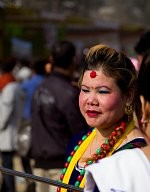
2018, Jan 15 - Maghi festival. New Year of Nepal in Tundikhel through the day. The festival had started from Kathmandu Durbar Square.
Noémie Repetto / Le Pictorium
LePictorium_0173477.jpg
Maghe Sankranti is the first day of the month of Magh of Bikram Sambat. Magh is the tenth month of the year.
Sankranti is the Sanskrit word in Eastern Astrology which refers to the transmigration of the Sun from one Rashi (sign of the zodiac) to another. In very simple, the word sankranti is the first day of the Nepali calendar. Then obviously, there are 12 sankrantis in a year. Makar Sankranti is the transition of the Sun from Dhanu rashi (Sagittarius) to Makara rashi (Capricorn).
In Hindu Astrology the sun position during the year is divided into 12 rashis (zodiac signs). It is however, very difficult to reconcile among Bikram Sambat months, Zodiac months and lunar calendar's months. While the traditional Calendar is based on lunar positions, Sankranti is a solar event. So dates of all Hindu festivals keep changing as per the Gregorian calendar and so do the Makar Sankranti too.
Makar Sankranti is the festival of the Sun God. The Sun God is the symbol of power, divinity and wisdom. The Sun God is worshiped in this festival.
Maghe Sankranti is also called Maghi. Maghi is for the New year of Tharu Community of Nepal.
Sankranti is the Sanskrit word in Eastern Astrology which refers to the transmigration of the Sun from one Rashi (sign of the zodiac) to another. In very simple, the word sankranti is the first day of the Nepali calendar. Then obviously, there are 12 sankrantis in a year. Makar Sankranti is the transition of the Sun from Dhanu rashi (Sagittarius) to Makara rashi (Capricorn).
In Hindu Astrology the sun position during the year is divided into 12 rashis (zodiac signs). It is however, very difficult to reconcile among Bikram Sambat months, Zodiac months and lunar calendar's months. While the traditional Calendar is based on lunar positions, Sankranti is a solar event. So dates of all Hindu festivals keep changing as per the Gregorian calendar and so do the Makar Sankranti too.
Makar Sankranti is the festival of the Sun God. The Sun God is the symbol of power, divinity and wisdom. The Sun God is worshiped in this festival.
Maghe Sankranti is also called Maghi. Maghi is for the New year of Tharu Community of Nepal.

2018, Jan 15 - Maghi festival. New Year of Nepal in Tundikhel through the day. The festival had started from Kathmandu Durbar Square.
Noémie Repetto / Le Pictorium
LePictorium_0173478.jpg
Maghe Sankranti is the first day of the month of Magh of Bikram Sambat. Magh is the tenth month of the year.
Sankranti is the Sanskrit word in Eastern Astrology which refers to the transmigration of the Sun from one Rashi (sign of the zodiac) to another. In very simple, the word sankranti is the first day of the Nepali calendar. Then obviously, there are 12 sankrantis in a year. Makar Sankranti is the transition of the Sun from Dhanu rashi (Sagittarius) to Makara rashi (Capricorn).
In Hindu Astrology the sun position during the year is divided into 12 rashis (zodiac signs). It is however, very difficult to reconcile among Bikram Sambat months, Zodiac months and lunar calendar's months. While the traditional Calendar is based on lunar positions, Sankranti is a solar event. So dates of all Hindu festivals keep changing as per the Gregorian calendar and so do the Makar Sankranti too.
Makar Sankranti is the festival of the Sun God. The Sun God is the symbol of power, divinity and wisdom. The Sun God is worshiped in this festival.
Maghe Sankranti is also called Maghi. Maghi is for the New year of Tharu Community of Nepal.
Sankranti is the Sanskrit word in Eastern Astrology which refers to the transmigration of the Sun from one Rashi (sign of the zodiac) to another. In very simple, the word sankranti is the first day of the Nepali calendar. Then obviously, there are 12 sankrantis in a year. Makar Sankranti is the transition of the Sun from Dhanu rashi (Sagittarius) to Makara rashi (Capricorn).
In Hindu Astrology the sun position during the year is divided into 12 rashis (zodiac signs). It is however, very difficult to reconcile among Bikram Sambat months, Zodiac months and lunar calendar's months. While the traditional Calendar is based on lunar positions, Sankranti is a solar event. So dates of all Hindu festivals keep changing as per the Gregorian calendar and so do the Makar Sankranti too.
Makar Sankranti is the festival of the Sun God. The Sun God is the symbol of power, divinity and wisdom. The Sun God is worshiped in this festival.
Maghe Sankranti is also called Maghi. Maghi is for the New year of Tharu Community of Nepal.
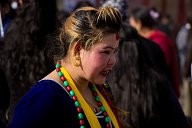
2018, Jan 15 - Maghi festival. New Year of Nepal in Tundikhel through the day. The festival had started from Kathmandu Durbar Square.
Noémie Repetto / Le Pictorium
LePictorium_0173479.jpg
Maghe Sankranti is the first day of the month of Magh of Bikram Sambat. Magh is the tenth month of the year.
Sankranti is the Sanskrit word in Eastern Astrology which refers to the transmigration of the Sun from one Rashi (sign of the zodiac) to another. In very simple, the word sankranti is the first day of the Nepali calendar. Then obviously, there are 12 sankrantis in a year. Makar Sankranti is the transition of the Sun from Dhanu rashi (Sagittarius) to Makara rashi (Capricorn).
In Hindu Astrology the sun position during the year is divided into 12 rashis (zodiac signs). It is however, very difficult to reconcile among Bikram Sambat months, Zodiac months and lunar calendar's months. While the traditional Calendar is based on lunar positions, Sankranti is a solar event. So dates of all Hindu festivals keep changing as per the Gregorian calendar and so do the Makar Sankranti too.
Makar Sankranti is the festival of the Sun God. The Sun God is the symbol of power, divinity and wisdom. The Sun God is worshiped in this festival.
Maghe Sankranti is also called Maghi. Maghi is for the New year of Tharu Community of Nepal.
Sankranti is the Sanskrit word in Eastern Astrology which refers to the transmigration of the Sun from one Rashi (sign of the zodiac) to another. In very simple, the word sankranti is the first day of the Nepali calendar. Then obviously, there are 12 sankrantis in a year. Makar Sankranti is the transition of the Sun from Dhanu rashi (Sagittarius) to Makara rashi (Capricorn).
In Hindu Astrology the sun position during the year is divided into 12 rashis (zodiac signs). It is however, very difficult to reconcile among Bikram Sambat months, Zodiac months and lunar calendar's months. While the traditional Calendar is based on lunar positions, Sankranti is a solar event. So dates of all Hindu festivals keep changing as per the Gregorian calendar and so do the Makar Sankranti too.
Makar Sankranti is the festival of the Sun God. The Sun God is the symbol of power, divinity and wisdom. The Sun God is worshiped in this festival.
Maghe Sankranti is also called Maghi. Maghi is for the New year of Tharu Community of Nepal.
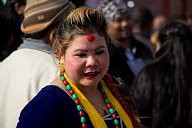
2018, Jan 15 - Maghi festival. New Year of Nepal in Tundikhel through the day. The festival had started from Kathmandu Durbar Square.
Noémie Repetto / Le Pictorium
LePictorium_0173480.jpg
Maghe Sankranti is the first day of the month of Magh of Bikram Sambat. Magh is the tenth month of the year.
Sankranti is the Sanskrit word in Eastern Astrology which refers to the transmigration of the Sun from one Rashi (sign of the zodiac) to another. In very simple, the word sankranti is the first day of the Nepali calendar. Then obviously, there are 12 sankrantis in a year. Makar Sankranti is the transition of the Sun from Dhanu rashi (Sagittarius) to Makara rashi (Capricorn).
In Hindu Astrology the sun position during the year is divided into 12 rashis (zodiac signs). It is however, very difficult to reconcile among Bikram Sambat months, Zodiac months and lunar calendar's months. While the traditional Calendar is based on lunar positions, Sankranti is a solar event. So dates of all Hindu festivals keep changing as per the Gregorian calendar and so do the Makar Sankranti too.
Makar Sankranti is the festival of the Sun God. The Sun God is the symbol of power, divinity and wisdom. The Sun God is worshiped in this festival.
Maghe Sankranti is also called Maghi. Maghi is for the New year of Tharu Community of Nepal.
Sankranti is the Sanskrit word in Eastern Astrology which refers to the transmigration of the Sun from one Rashi (sign of the zodiac) to another. In very simple, the word sankranti is the first day of the Nepali calendar. Then obviously, there are 12 sankrantis in a year. Makar Sankranti is the transition of the Sun from Dhanu rashi (Sagittarius) to Makara rashi (Capricorn).
In Hindu Astrology the sun position during the year is divided into 12 rashis (zodiac signs). It is however, very difficult to reconcile among Bikram Sambat months, Zodiac months and lunar calendar's months. While the traditional Calendar is based on lunar positions, Sankranti is a solar event. So dates of all Hindu festivals keep changing as per the Gregorian calendar and so do the Makar Sankranti too.
Makar Sankranti is the festival of the Sun God. The Sun God is the symbol of power, divinity and wisdom. The Sun God is worshiped in this festival.
Maghe Sankranti is also called Maghi. Maghi is for the New year of Tharu Community of Nepal.
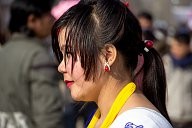
2018, Jan 15 - Maghi festival. New Year of Nepal in Tundikhel through the day. The festival had started from Kathmandu Durbar Square.
Noémie Repetto / Le Pictorium
LePictorium_0173481.jpg
Maghe Sankranti is the first day of the month of Magh of Bikram Sambat. Magh is the tenth month of the year.
Sankranti is the Sanskrit word in Eastern Astrology which refers to the transmigration of the Sun from one Rashi (sign of the zodiac) to another. In very simple, the word sankranti is the first day of the Nepali calendar. Then obviously, there are 12 sankrantis in a year. Makar Sankranti is the transition of the Sun from Dhanu rashi (Sagittarius) to Makara rashi (Capricorn).
In Hindu Astrology the sun position during the year is divided into 12 rashis (zodiac signs). It is however, very difficult to reconcile among Bikram Sambat months, Zodiac months and lunar calendar's months. While the traditional Calendar is based on lunar positions, Sankranti is a solar event. So dates of all Hindu festivals keep changing as per the Gregorian calendar and so do the Makar Sankranti too.
Makar Sankranti is the festival of the Sun God. The Sun God is the symbol of power, divinity and wisdom. The Sun God is worshiped in this festival.
Maghe Sankranti is also called Maghi. Maghi is for the New year of Tharu Community of Nepal.
Sankranti is the Sanskrit word in Eastern Astrology which refers to the transmigration of the Sun from one Rashi (sign of the zodiac) to another. In very simple, the word sankranti is the first day of the Nepali calendar. Then obviously, there are 12 sankrantis in a year. Makar Sankranti is the transition of the Sun from Dhanu rashi (Sagittarius) to Makara rashi (Capricorn).
In Hindu Astrology the sun position during the year is divided into 12 rashis (zodiac signs). It is however, very difficult to reconcile among Bikram Sambat months, Zodiac months and lunar calendar's months. While the traditional Calendar is based on lunar positions, Sankranti is a solar event. So dates of all Hindu festivals keep changing as per the Gregorian calendar and so do the Makar Sankranti too.
Makar Sankranti is the festival of the Sun God. The Sun God is the symbol of power, divinity and wisdom. The Sun God is worshiped in this festival.
Maghe Sankranti is also called Maghi. Maghi is for the New year of Tharu Community of Nepal.
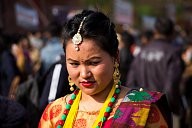
2018, Jan 15 - Maghi festival. New Year of Nepal in Tundikhel through the day. The festival had started from Kathmandu Durbar Square.
Noémie Repetto / Le Pictorium
LePictorium_0173482.jpg
Maghe Sankranti is the first day of the month of Magh of Bikram Sambat. Magh is the tenth month of the year.
Sankranti is the Sanskrit word in Eastern Astrology which refers to the transmigration of the Sun from one Rashi (sign of the zodiac) to another. In very simple, the word sankranti is the first day of the Nepali calendar. Then obviously, there are 12 sankrantis in a year. Makar Sankranti is the transition of the Sun from Dhanu rashi (Sagittarius) to Makara rashi (Capricorn).
In Hindu Astrology the sun position during the year is divided into 12 rashis (zodiac signs). It is however, very difficult to reconcile among Bikram Sambat months, Zodiac months and lunar calendar's months. While the traditional Calendar is based on lunar positions, Sankranti is a solar event. So dates of all Hindu festivals keep changing as per the Gregorian calendar and so do the Makar Sankranti too.
Makar Sankranti is the festival of the Sun God. The Sun God is the symbol of power, divinity and wisdom. The Sun God is worshiped in this festival.
Maghe Sankranti is also called Maghi. Maghi is for the New year of Tharu Community of Nepal.
Sankranti is the Sanskrit word in Eastern Astrology which refers to the transmigration of the Sun from one Rashi (sign of the zodiac) to another. In very simple, the word sankranti is the first day of the Nepali calendar. Then obviously, there are 12 sankrantis in a year. Makar Sankranti is the transition of the Sun from Dhanu rashi (Sagittarius) to Makara rashi (Capricorn).
In Hindu Astrology the sun position during the year is divided into 12 rashis (zodiac signs). It is however, very difficult to reconcile among Bikram Sambat months, Zodiac months and lunar calendar's months. While the traditional Calendar is based on lunar positions, Sankranti is a solar event. So dates of all Hindu festivals keep changing as per the Gregorian calendar and so do the Makar Sankranti too.
Makar Sankranti is the festival of the Sun God. The Sun God is the symbol of power, divinity and wisdom. The Sun God is worshiped in this festival.
Maghe Sankranti is also called Maghi. Maghi is for the New year of Tharu Community of Nepal.
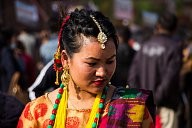
2018, Jan 15 - Maghi festival. New Year of Nepal in Tundikhel through the day. The festival had started from Kathmandu Durbar Square.
Noémie Repetto / Le Pictorium
LePictorium_0173483.jpg
Maghe Sankranti is the first day of the month of Magh of Bikram Sambat. Magh is the tenth month of the year.
Sankranti is the Sanskrit word in Eastern Astrology which refers to the transmigration of the Sun from one Rashi (sign of the zodiac) to another. In very simple, the word sankranti is the first day of the Nepali calendar. Then obviously, there are 12 sankrantis in a year. Makar Sankranti is the transition of the Sun from Dhanu rashi (Sagittarius) to Makara rashi (Capricorn).
In Hindu Astrology the sun position during the year is divided into 12 rashis (zodiac signs). It is however, very difficult to reconcile among Bikram Sambat months, Zodiac months and lunar calendar's months. While the traditional Calendar is based on lunar positions, Sankranti is a solar event. So dates of all Hindu festivals keep changing as per the Gregorian calendar and so do the Makar Sankranti too.
Makar Sankranti is the festival of the Sun God. The Sun God is the symbol of power, divinity and wisdom. The Sun God is worshiped in this festival.
Maghe Sankranti is also called Maghi. Maghi is for the New year of Tharu Community of Nepal.
Sankranti is the Sanskrit word in Eastern Astrology which refers to the transmigration of the Sun from one Rashi (sign of the zodiac) to another. In very simple, the word sankranti is the first day of the Nepali calendar. Then obviously, there are 12 sankrantis in a year. Makar Sankranti is the transition of the Sun from Dhanu rashi (Sagittarius) to Makara rashi (Capricorn).
In Hindu Astrology the sun position during the year is divided into 12 rashis (zodiac signs). It is however, very difficult to reconcile among Bikram Sambat months, Zodiac months and lunar calendar's months. While the traditional Calendar is based on lunar positions, Sankranti is a solar event. So dates of all Hindu festivals keep changing as per the Gregorian calendar and so do the Makar Sankranti too.
Makar Sankranti is the festival of the Sun God. The Sun God is the symbol of power, divinity and wisdom. The Sun God is worshiped in this festival.
Maghe Sankranti is also called Maghi. Maghi is for the New year of Tharu Community of Nepal.
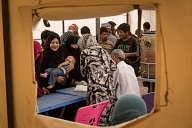
Syria: Ain Issa displaced people camp
Chris Huby / Le Pictorium
LePictorium_0165807.jpg
July 2017 - Syria - Rojava - Northern Syria - Ain Issa displaced people camp / Doctors Without Borders Clinic / Atmosphere of the waiting room.
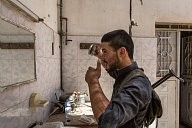
SYRIE / The Freedom Katiba against RAQQA / LIWA AL TAHRIR
Chris Huby / Le Pictorium
LePictorium_0165317.jpg
Syria / Raqqa / West District / Hawi al-Hawa / Frontline. Atmosphere in the house, the Arab fighters are busy waiting for the new orders that will arrive. Scene of life in front of the bathroom mirror.
Several Arab groups of the SDF (Syrian Democratic Forces) are installed in houses taken over in Daesh. This unit belongs to Liwa Al-Tharir, a brigade of Arab fighters who decided to fight with the fanatics of the EI.
Several Arab groups of the SDF (Syrian Democratic Forces) are installed in houses taken over in Daesh. This unit belongs to Liwa Al-Tharir, a brigade of Arab fighters who decided to fight with the fanatics of the EI.
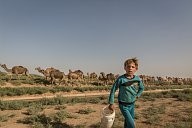
SYRIA / ROJAVA / RAQQA IS BLEEDING - WRATH OF THE EUPHRATE June/July 2017
Chris Huby / Le Pictorium
LePictorium_0164800.jpg
July 2017 - Syria / ROJAVA (Syrian North) / Road to Raqqa / A young Syrian walks in front of a large herd of dromedaries. Towards the center of the country, not far from Raqqa, the land becomes desert. The dromedaries are prized in the region, bred by the Bedouins
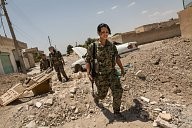
SYRIA / ROJAVA / RAQQA IS BLEEDING - WRATH OF THE EUPHRATE June/July 2017
Chris Huby / Le Pictorium
LePictorium_0164836.jpg
July 2017 - Syria / ROJAVA (Northern Syria) / Raqqa West / Frontline / YPJ soldiers cross a street destroyed by the conflict. Kurds use men and women equally throughout society, including the military.

SYRIA - THE MARTYRDOM OF KHABOUR'S ASSYRIANS
Chris Huby / Le Pictorium
LePictorium_0159726.jpg
SYRIA / NORTH SYRIEN / Dec16 / HASSAKE - Portrait of two Christians. Lydie (left) explains that young women find it difficult to find spouses. Men are moving abroad more and more.
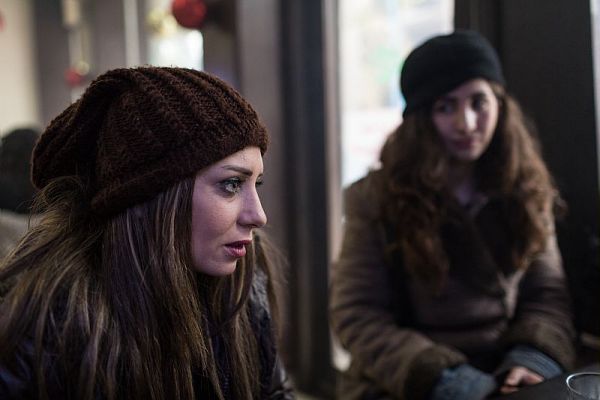
SYRIA - THE MARTYRDOM OF KHABOUR'S ASSYRIANS
Chris Huby / Le Pictorium
LePictorium_0159727.jpg
SYRIA / NORTH SYRIEN / Dec16 / HASSAKE - Portrait of two Christians. Lydie (left) explains that young women find it difficult to find spouses. Men are moving abroad more and more.
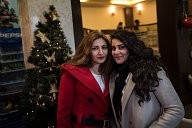
SYRIA - THE MARTYRDOM OF KHABOUR'S ASSYRIANS
Chris Huby / Le Pictorium
LePictorium_0159728.jpg
SYRIA / NORTH SYRIA / Dec16 / HASSAKE - Two Christians in the days before Christmas.

SYRIA - THE MARTYRDOM OF KHABOUR'S ASSYRIANS
Chris Huby / Le Pictorium
LePictorium_0159748.jpg
SYRIA / NORTH SYRIEN / 24 Dec16 / HASSAKE - The Orthodox Syriac Scouts are preparing for the Christmas party.
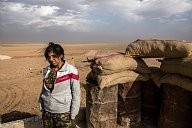
Syria / Rojava - Wrath of the Euphrates
Chris Huby / Le Pictorium
LePictorium_0159520.jpg
SYRIA ROJAVA / Portrait of a YPJ soldier for the Raqqa operations. Ain-Issa, zone located a few kms of the jihadist stronghold. A YPJ soldier in the military camp.
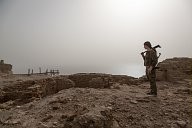
Syria / Rojava - Wrath of the Euphrates
Chris Huby / Le Pictorium
LePictorium_0159578.jpg
Jan 7- SYRIA ROJAVA / NORTH SYRIA / NEAR RAQQA / QALAT JABAR CASTLE - The SDF (Syrian Democratic Forces) with YPG (kurds) took back the famous castle from ISIS. A YPG soldier is going trough the castle.

Effects of the increased number of border jumpers at the border USA/Canada in Manitoba.
Arnaud De Grave / Le Pictorium
LePictorium_0158614.jpg
Karin Gordon works for an association
helping asylum seekers. She is retired (she
was a doctor in x-rays and radiation for
medicinal use) but cannot stay inactive.
helping asylum seekers. She is retired (she
was a doctor in x-rays and radiation for
medicinal use) but cannot stay inactive.

Effects of the increased number of border jumpers at the border USA/Canada in Manitoba.
Arnaud De Grave / Le Pictorium
LePictorium_0158615.jpg
Karin Gordon works for an association
helping asylum seekers. She is retired (she
was a doctor in x-rays and radiation for
medicinal use) but cannot stay inactive.
helping asylum seekers. She is retired (she
was a doctor in x-rays and radiation for
medicinal use) but cannot stay inactive.

Effects of the increased number of border jumpers at the border USA/Canada in Manitoba.
Arnaud De Grave / Le Pictorium
LePictorium_0158616.jpg
Karin Gordon works for an association
helping asylum seekers. She is retired (she
was a doctor in x-rays and radiation for
medicinal use) but cannot stay inactive.
helping asylum seekers. She is retired (she
was a doctor in x-rays and radiation for
medicinal use) but cannot stay inactive.

Effects of the increased number of border jumpers at the border USA/Canada in Manitoba.
Arnaud De Grave / Le Pictorium
LePictorium_0158617.jpg
Karin Gordon works for an association
helping asylum seekers. She is retired (she
was a doctor in x-rays and radiation for
medicinal use) but cannot stay inactive.
helping asylum seekers. She is retired (she
was a doctor in x-rays and radiation for
medicinal use) but cannot stay inactive.

Effects of the increased number of border jumpers at the border USA/Canada in Manitoba.
Arnaud De Grave / Le Pictorium
LePictorium_0158618.jpg
Karin brings the kids of the Somalian family to a concert at the St Mary (United Church) in Winnipeg. They are muslims and it is their first time in a Christian church.
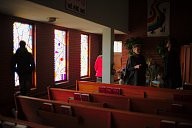
Effects of the increased number of border jumpers at the border USA/Canada in Manitoba.
Arnaud De Grave / Le Pictorium
LePictorium_0158619.jpg
Karin brings the kids of the Somalian family to a concert at the St Mary (United Church) in Winnipeg. They are muslims and it is their first time in a Christian church.

Effects of the increased number of border jumpers at the border USA/Canada in Manitoba.
Arnaud De Grave / Le Pictorium
LePictorium_0158620.jpg
Karin Gordon works for an association
helping asylum seekers. She is retired (she
was a doctor in x-rays and radiation for
medicinal use) but cannot stay inactive.
helping asylum seekers. She is retired (she
was a doctor in x-rays and radiation for
medicinal use) but cannot stay inactive.

Effects of the increased number of border jumpers at the border USA/Canada in Manitoba.
Arnaud De Grave / Le Pictorium
LePictorium_0158593.jpg
Kellie Leitch is a representative of the Conservative party, in Ottawa. She campaigns for the party presidency and hopes to run for Prime Minister at the next elections. She considers Justin Trudeau irresponsible when he said everybody is welcome to Canada after the Trump decision to close the borders for some countries. She visits Emerson to be in the field and understand the situation, something Trudeau never did.

Effects of the increased number of border jumpers at the border USA/Canada in Manitoba.
Arnaud De Grave / Le Pictorium
LePictorium_0158600.jpg
Karin Gordon works for an association
helping asylum seekers. She is retired (she
was a doctor in x-rays and radiation for
medicinal use) but cannot stay inactive.
helping asylum seekers. She is retired (she
was a doctor in x-rays and radiation for
medicinal use) but cannot stay inactive.

Effects of the increased number of border jumpers at the border USA/Canada in Manitoba.
Arnaud De Grave / Le Pictorium
LePictorium_0158607.jpg
Flats proposed for refugees and managed by different organisations. Here a Somalian has been hosted since a few weeks, the kids are now registered at the local school
and class will begin soon.
and class will begin soon.

Effects of the increased number of border jumpers at the border USA/Canada in Manitoba.
Arnaud De Grave / Le Pictorium
LePictorium_0158608.jpg
Karin and Abdi Rahman (16 years old), oldes of a family of 8. They left Somalia for Kenya and then Vancouver with fake ids. They were then shuttled to Winnipeg in a van, driving non-stop for 3 days and abandoned close by the association where Karin works. He can speak good english which was a chance for them. 4 boys and 3 girls, from 9 to
16, were threatened in Somalia: the boys would have been forced to become children soldiers and the girls sex slaves or forced wives.
16, were threatened in Somalia: the boys would have been forced to become children soldiers and the girls sex slaves or forced wives.

Effects of the increased number of border jumpers at the border USA/Canada in Manitoba.
Arnaud De Grave / Le Pictorium
LePictorium_0158611.jpg
Karin and Abdi Rahman (16 years old), oldes of a family of 8. They left Somalia for Kenya and then Vancouver with fake ids. They were then shuttled to Winnipeg in a van, driving non-stop for 3 days and abandoned close by the association where Karin works. He can speak good english which was a chance for them. 4 boys and 3 girls, from 9 to
16, were threatened in Somalia: the boys would have been forced to become children soldiers and the girls sex slaves or forced wives.
16, were threatened in Somalia: the boys would have been forced to become children soldiers and the girls sex slaves or forced wives.
Next page
